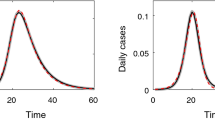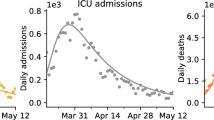Abstract
The successful application of epidemic models hinges on our ability to estimate model parameters from limited observations reliably. An often-overlooked step before estimating model parameters consists of ensuring that the model parameters are structurally identifiable from the observed states of the system. In this tutorial-based primer, intended for a diverse audience, including students training in dynamic systems, we review and provide detailed guidance for conducting structural identifiability analysis of differential equation epidemic models based on a differential algebra approach using differential algebra for identifiability of systems (DAISY) and Mathematica (Wolfram Research). This approach aims to uncover any existing parameter correlations that preclude their estimation from the observed variables. We demonstrate this approach through examples, including tutorial videos of compartmental epidemic models previously employed to study transmission dynamics and control. We show that the lack of structural identifiability may be remedied by incorporating additional observations from different model states, assuming that the system’s initial conditions are known, using prior information to fix some parameters involved in parameter correlations, or modifying the model based on existing parameter correlations. We also underscore how the results of structural identifiability analysis can help enrich compartmental diagrams of differential-equation models by indicating the observed state variables and the results of the structural identifiability analysis.



















Similar content being viewed by others
References
Anderson R, Fraser C, Ghani A, Donnelly C, Riley S, Ferguson N, Leung G, Lam T, Hedley A (2004) Epidemiology, transmission dynamics and control of SARS: the 2002–2003 epidemic. Phil Trans R Soc Lond B 359(1447):1091–1105
Anderson R, Heesterbeek H, Klinkenberg D, Hollingsworth T (2020) How will country-based mitigation measures influence the course of the COVID-19 epidemic? Lancet 395(10228):931–934
Arino J, Brauer F, van den Driessche P, Watmough J, Wu J (2006) Simple models for containment of a pandemic. J R Soc Interface 3(8):453–457
Banks HT, Tran HT (2009) Mathematical and experimental modeling of physical and biological processes. CRC Press, Boca Raton
Bellman R, Åström K (1970) On structural identifiability. Math Biosci 7(3–4):329–339
Bellu G, Saccomani M, Audoly S, D’Angiò L (2007) DAISY: a new software tool to test global identifiability of biological and physiological systems. Comput Methods Programs Biomed 88:52–61
Brauer F (2006) Some simple epidemic models. Math Biosci Eng 3(1):1–15
Brauer F, Castillo-Chavez C, Feng Z (2019) Mathematical models in epidemiology. Springer, Berlin
Chatzis M, Chatzi E, Smyth A (2015) On the observability and identifiability of nonlinear structural and mechanical systems. Struct Control Health Monit 22:574–593
Chis O, Banga J, Balsa-Canto E (2011) Structural identifiability of systems biology models: a critical comparison of methods. PLoS ONE 6(11):e27755
Chowell G, Ammon C, Hengartner N, Hyman J (2006a) Transmission dynamics of the great influenza pandemic of 1918 in Geneva, Switzerland: assessing the effects of hypothetical interventions. J Theor Biol 241:193–204
Chowell G, Castillo-Chavez C, Fenimore P, Kribs-Zaleta C, Arriola L, Hyman J (2004) Model parameters and outbreak control for SARS. Emerg Infect Dis 10(7):1258–1263
Chowell G, Nishiura H, Bettencourt L (2007) Comparative estimation of the reproduction number for pandemic influenza from daily case notification data. J R Soc Interface, 4
Chowell G, Shim E, Brauer F, Diaz-Dueñas P, Hyman J, Castillo-Chavez C (2006b) Modelling the transmission dynamics of acute haemorrhagic conjunctivitis: application to the 2003 outbreak in Mexico. Stat Med 25(11):1840–1857
Cobelli C, Distefano JJ 3rd (1980) Parameter and structural identifiability concepts and ambiguities: a critical review and analysis. Am J Physiol - Regul Integr Comp Physiol 239:R7–R24
Denis-Vidal L, Joly-Blanchard G, Noiret C (2001) Some effective approaches to check the identifiability of uncontrolled nonlinear systems. Math Comput Simul 57(1–2):35–44
Distefano J, Cobelli C (1980) On parameter and structural identifiability: nonunique observability/reconstructibility for identifiable systems, other ambiguities, and new definitions. IEEE Trans Autom Control 25(4):830–833
Eisenberg M, Robertson S, Tien J (2013) Identifiability and estimation of multiple transmission pathways in cholera and waterborne disease. J Theor Biol 324:84–102
Gallo L, Frasca M, Latora V, Giovanni R (2022) Lack of practical identifiability may hamper reliable predictions in COVID-19 epidemic models. Sci Adv 8(3):eabg5234
Guillaume J, Jakeman J, Marsili-Libelli S, Asher M, Brunner P, Croke B, Hill M, Jakeman A, Keesman K, Razavi S et al (2019) Introductory overview of identifiability analysis: A guide to evaluating whether you have the right type of data for your modeling purpose. Environ Model Softw 119:418–432
Gumel A, Ruan S, Day T, Watmough J, Brauer F, Van den Driessche P, Gabrielson D, Bowman C, Alexander M, Ardal S, Wu J, Sahai B (2004) Modelling strategies for controlling SARS outbreaks. Proc R Soc Lond B 271(1554):2223–2232
Hong H, Ovchinnikov A, Pogudin G, Yap C (2019) SIAN: software for structural identifiability analysis of ODE models. Bioinformatics 35(16):2873–2874
Legrand J, Grais R, Boelle P, Valleron A, Flahault A (2007) Understanding the dynamics of Ebola epidemics. Epidemiol Infect 135:610–621
Ljung L, Glad T (1991) Testing global identifiability for arbitrary model parameterizations. IFAC Proc Vol. 24:1085–1090
Ljung L, Glad T (1994) On global identifiability for arbitrary model parametrizations. Automatica 30(2):265–276
Meshkat N, Eisenberg M, DiStefano JJ 3rd (2009) An algorithm for finding globally identifiable parameter combinations of nonlinear ODE models using Gröbner bases. Math Biosci 222:61–72
Miao H, Xia X, Perelson A, Wu H (2011) On identifiability of nonlinear ODE models and applications in viral dynamics. SIAM Rev 53(1):3–39
Ogungbenro K, Aarons L (2011) Structural identifiability analysis of pharmacokinetic models using DAISY: semi-mechanistic gastric emptying models for 13C-octanoic acid. J Pharmacokinet Pharmacodyn 38:279–292
Piazzola C, Tamellini L, Tempone R (2021) A note on tools for prediction under uncertainty and identifiability of SIR-like dynamical systems for epidemiology. Math Biosci 332:108514
Pohjanpalo H (1978) System identifiability based on the power series expansion of the solution. Math Biosci 41:21–33
Roosa K, Chowell G (2019) Assessing parameter identifiability in compartmental dynamic models using a computational approach: application to infectious disease transmission models. Theor Biol Med Model, 16(1)
Saccomani M, Audoly S, Bellu G, D’Angiò L (2010) Examples of testing global identifiability of biological and biomedical models with the DAISY software. Comput Biol Med 40:402–407
Saccomani M, Bellu G (2008) DAISY: an efficient tool to test global identifiability. Some case studies. In: 2008 16th mediterranean conference on control and automation, pp. 1723–1728. IEEE
Sauer T, Berry T, Ebeigbe D, Norton M, Whalen A, Schiff S (2021) Identifiability of infection model parameters early in an epidemic. SIAM J Control Optim 60(2):S27–S48
Tuncer N, Le T (2018) Structural and practical identifiability analysis of outbreak models. Math Biosci 299:1–18
Tuncer N, Timsina A, Nuno M, Chowell G, Martcheva M (2022) Parameter identifiability and optimal control of an SARS-CoV-2 model early in the pandemic. J Biol Dyn 16:412–438
Vajda S, Godfrey KR, Rabitz H (1989) Similarity transformation approach to identifiability analysis of nonlinear compartmental models. Math Biosci 93(2):217–248
Villaverde A, Barreiro A, Papachristodoulou A (2016) Structural identifiability of dynamic systems biology models. PLoS Comput Biol 12(10):e1005153
Walter E, Lecourtier Y (1982) Global approaches to identifiability testing for linear and nonlinear state space models. Math Comput Simul 24(6):472–482
Yan P, Chowell G (2019) Quantitative methods for investigating infectious disease outbreaks, vol 70. Springer, Berlin
Zhang S, Ponce J, Zhang Z, Lin G, Karniadakis G (2021) An integrated framework for building trustworthy data-driven epidemiological models: Application to the COVID-19 outbreak in New York City. PLoS Comput Biol 17(9):e1009334
Acknowledgements
G.C. is partially supported from NSF Grants 2125246 and 2026797 and R01 GM 130900.
Author information
Authors and Affiliations
Corresponding author
Ethics declarations
Conflict of interest
The authors report no conflicts of interests related to this article.
Additional information
Publisher's Note
Springer Nature remains neutral with regard to jurisdictional claims in published maps and institutional affiliations.
Appendix
Appendix
1.1 Input–output equations of epidemic models
\(\underline{\hbox {Input-output equation of the model }{\hbox {M}}_2}\)
\(\underline{\hbox {Input-output equation of the model }{\hbox {M}}_3}\)
Rights and permissions
Springer Nature or its licensor (e.g. a society or other partner) holds exclusive rights to this article under a publishing agreement with the author(s) or other rightsholder(s); author self-archiving of the accepted manuscript version of this article is solely governed by the terms of such publishing agreement and applicable law.
About this article
Cite this article
Chowell, G., Dahal, S., Liyanage, Y.R. et al. Structural identifiability analysis of epidemic models based on differential equations: a tutorial-based primer. J. Math. Biol. 87, 79 (2023). https://doi.org/10.1007/s00285-023-02007-2
Received:
Revised:
Accepted:
Published:
DOI: https://doi.org/10.1007/s00285-023-02007-2
Keywords
- Structural identifiability
- Epidemic models
- Parameter correlations
- DAISY
- Differential algebra
- Differential equations




